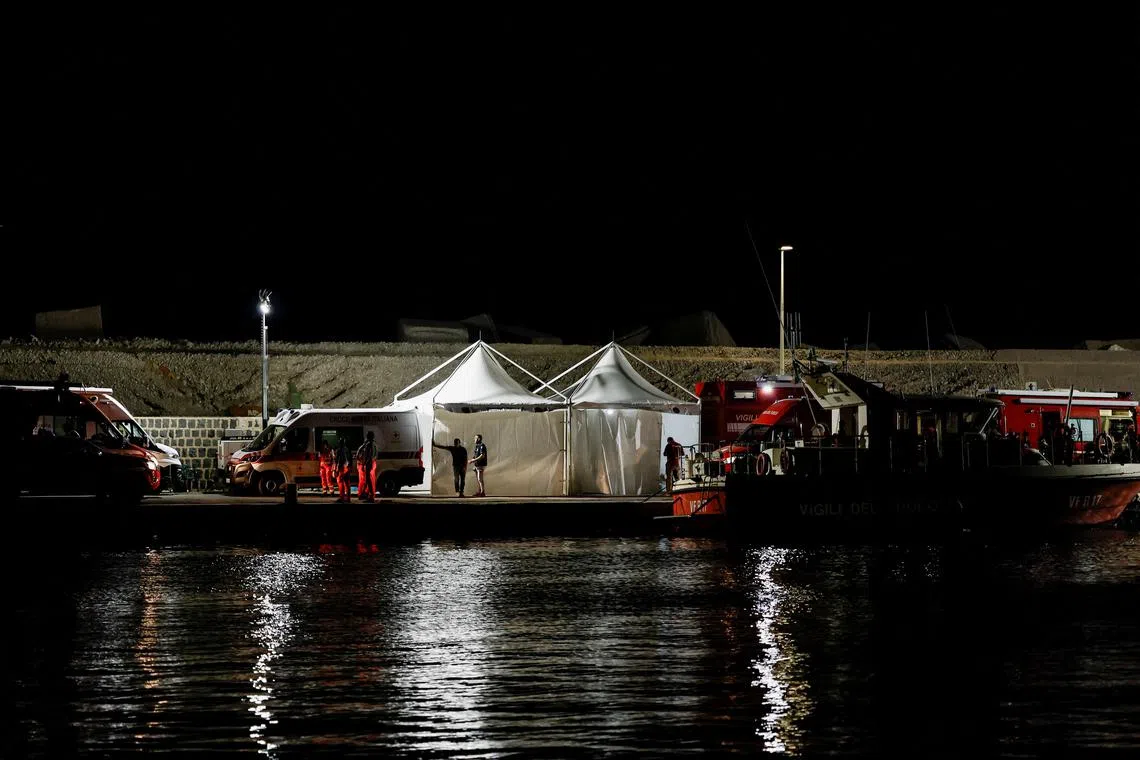How a waterspout may have sunk a UK tech tycoon’s yacht
Sign up now: Get ST's newsletters delivered to your inbox

Officials working near a site where a luxury yacht sank, in Porticello, near the Sicilian city of Palermo, Italy.
PHOTO: REUTERS
Follow topic:
PORTICELLO, Italy - The marine weather phenomenon blamed for sinking a British tech tycoon’s yacht off Sicily, known as a waterspout, may have been strengthened by unusually warm waters in the Mediterranean, experts said.
The 56m Bayesian, being used by Mr Mike Lynch and his wealthy guests to celebrate a court victory, disappeared into the sea within minutes of being hit by the tornado-like storm off the Sicilian town of Porticello.
One body has been found, and Mr Lynch, his daughter, and Mr Jonathan Bloomer, chairman of Morgan Stanley International, are among six people missing since the disaster at 4am local time on Aug 19.
The British-flagged vessel was anchored some 700m from port with 10 crew and 12 passengers on board when the waterspout struck, according to witnesses.
Mr Karsten Borner, skipper of a yacht anchored nearby, described a “very strong hurricane gust” that hit. He was battling to keep his vessel steady when suddenly “we noticed that the ship behind us was gone”.
“First came the wind, then the water – it was definitely a tornado,” said local fisherman Giovanni Lococco, describing the waterspout.
Tornado power
Investigators and experts have been poring over the weather conditions and the design of the Bayesian, whose 75m mast was the world’s tallest made from aluminium, according to the Charter World website.
“A waterspout is a narrow column of rotating air below a thunderstorm that occurs over water” and is “part of the same weather ‘family’ as tornadoes”, said Professor Peter Inness, a meteorologist at the University of Reading in Britain, in comments released by Britain’s Science Media Centre.
Like tornadoes, they suck up air in a rotating motion, usually causing less damage than tornadoes over land, however.
“Changes in wind direction with height are also needed to set up the rotation of air within the waterspout,” said Prof Inness.
While many waterspouts are “fairly inconsequential”, lasting just a few seconds, some can pack winds of more than 100kmh, said Prof Inness.
“Winds of this strength coinciding with the location of a boat are capable of causing damage or capsize, especially because the wind direction varies very rapidly,” he said.
The Mediterranean could be the world’s most likely place for waterspouts, due to a warm water surface and a vulnerability to thunderstorms in the summer and autumn, he said.
The Mediterranean in 2024 reached its highest temperature on record, with a daily median of 28.9 deg C, according to Spain’s leading institute of marine sciences.
Experts say the temperature has often hit 30 deg C or more, about 3 deg C above average.
“We could have had a superposition of air and water suction with shearing winds that ultimately created something that lifted up,” said Mr Jean-Marie Dumon, a former naval officer now with the Gican, the French maritime industry association.
The conditions with winds of 100kmh or more can “create completely anarchic sea conditions which can cause capsizing”, said Mr Dumon.
The tall mast may have had an “amplifier effect” in taking the yacht to its “tipping point”, he explained.
Mr Dumon said the Bayesian was certainly designed by naval architects to cope with extreme winds and heavy seas.
“Here we have wind shear which can cause instability.”
“The fact that the vessel itself was not damaged... suggests that it was laid on its side,” said the expert. AFP

